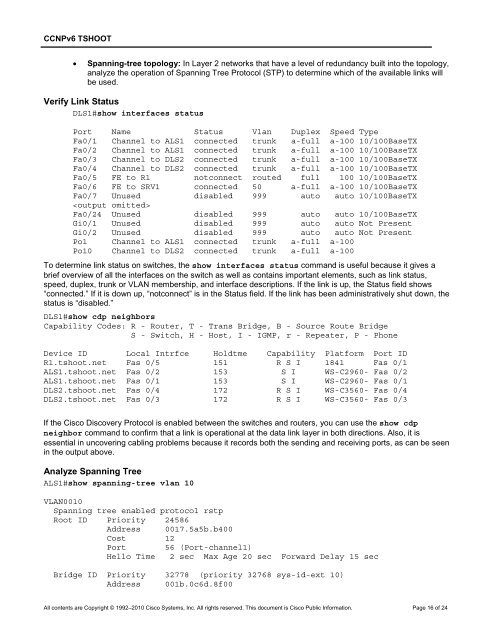CCNP TSHOOT 6.0 - The Cisco Learning Network
CCNP TSHOOT 6.0 - The Cisco Learning Network
CCNP TSHOOT 6.0 - The Cisco Learning Network
You also want an ePaper? Increase the reach of your titles
YUMPU automatically turns print PDFs into web optimized ePapers that Google loves.
<strong>CCNP</strong>v6 <strong>TSHOOT</strong><br />
• Spanning-tree topology: In Layer 2 networks that have a level of redundancy built into the topology,<br />
analyze the operation of Spanning Tree Protocol (STP) to determine which of the available links will<br />
be used.<br />
Verify Link Status<br />
DLS1#show interfaces status<br />
Port Name Status Vlan Duplex Speed Type<br />
Fa0/1 Channel to ALS1 connected trunk a-full a-100 10/100BaseTX<br />
Fa0/2 Channel to ALS1 connected trunk a-full a-100 10/100BaseTX<br />
Fa0/3 Channel to DLS2 connected trunk a-full a-100 10/100BaseTX<br />
Fa0/4 Channel to DLS2 connected trunk a-full a-100 10/100BaseTX<br />
Fa0/5 FE to R1 notconnect routed full 100 10/100BaseTX<br />
Fa0/6 FE to SRV1 connected 50 a-full a-100 10/100BaseTX<br />
Fa0/7 Unused disabled 999 auto auto 10/100BaseTX<br />
<br />
Fa0/24 Unused disabled 999 auto auto 10/100BaseTX<br />
Gi0/1 Unused disabled 999 auto auto Not Present<br />
Gi0/2 Unused disabled 999 auto auto Not Present<br />
Po1 Channel to ALS1 connected trunk a-full a-100<br />
Po10 Channel to DLS2 connected trunk a-full a-100<br />
To determine link status on switches, the show interfaces status command is useful because it gives a<br />
brief overview of all the interfaces on the switch as well as contains important elements, such as link status,<br />
speed, duplex, trunk or VLAN membership, and interface descriptions. If the link is up, the Status field shows<br />
“connected.” If it is down up, “notconnect” is in the Status field. If the link has been administratively shut down, the<br />
status is “disabled.”<br />
DLS1#show cdp neighbors<br />
Capability Codes: R - Router, T - Trans Bridge, B - Source Route Bridge<br />
S - Switch, H - Host, I - IGMP, r - Repeater, P - Phone<br />
Device ID Local Intrfce Holdtme Capability Platform Port ID<br />
R1.tshoot.net Fas 0/5 151 R S I 1841 Fas 0/1<br />
ALS1.tshoot.net Fas 0/2 153 S I WS-C2960- Fas 0/2<br />
ALS1.tshoot.net Fas 0/1 153 S I WS-C2960- Fas 0/1<br />
DLS2.tshoot.net Fas 0/4 172 R S I WS-C3560- Fas 0/4<br />
DLS2.tshoot.net Fas 0/3 172 R S I WS-C3560- Fas 0/3<br />
If the <strong>Cisco</strong> Discovery Protocol is enabled between the switches and routers, you can use the show cdp<br />
neighbor command to confirm that a link is operational at the data link layer in both directions. Also, it is<br />
essential in uncovering cabling problems because it records both the sending and receiving ports, as can be seen<br />
in the output above.<br />
Analyze Spanning Tree<br />
ALS1#show spanning-tree vlan 10<br />
VLAN0010<br />
Spanning tree enabled protocol rstp<br />
Root ID Priority 24586<br />
Address 0017.5a5b.b400<br />
Cost 12<br />
Port 56 (Port-channel1)<br />
Hello Time 2 sec Max Age 20 sec Forward Delay 15 sec<br />
Bridge ID Priority 32778 (priority 32768 sys-id-ext 10)<br />
Address 001b.0c6d.8f00<br />
All contents are Copyright © 1992–2010 <strong>Cisco</strong> Systems, Inc. All rights reserved. This document is <strong>Cisco</strong> Public Information. Page 16 of 24

















